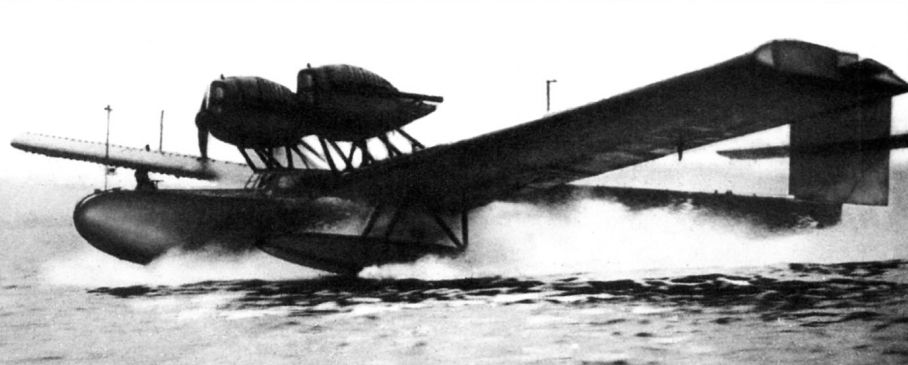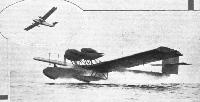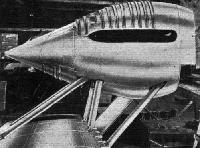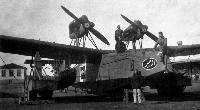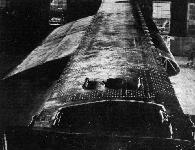Rohrbach. Самолеты
Дипломированный инженер Адольф Рорбах получил известность благодаря своей работе в компании "Zeppelin Werke Staaken GmbH" во время Первой мировой войны. В 1922 году он образовал собственную компанию "Rohrbach Metall Flugzeugbau GmbH".
Первый самолет новой фирмы отличала работающая гладкая обшивка из алюминиевого сплава без характерного для того периода гофра. Сборка самолета велась дочерней фирмой "Rohrbach Metall-Aeroplan А/S", зарегистрированной в Копенгагене, так как строительство самолетов в Германии было запрещено по условиям Версальского договора. Завод в Дании закрыли в конце 1920-х годов, когда возобновилось самолетостроение в Германии.
Многие из самолетов компании "Rohrbach Metall" представляли собой развитие машин, разрабатывавшихся в период работы Адольфа Рорбаха в подразделении "Zeppelin Werke" в Стаакене.
Первой стала летающая лодка Ro II с двумя моторами Rolls-Royce Eagle мощностью по 360 л. с. (268 кВт). В октябре 1924 года одна такая лодка подняла груз массой 250 кг, установив рекорды FAI в скорости полета на дистанциях 100 км, 200 км, 500 км и 1000 км, максимальная рекордная скорость - 159,15 км/ч.
Документация по самолету Ro III была продана в Японию, где компании "Mitsubishi Shoji Kaisha", "Hiro" и военно-морской арсенал в Йокосуке построили по одной копии с разными моторами.
Был разработан вариант на основе японской Ro III, его построили на заводе "Rohrbach" как Ro IIIa Rodra.
Ro IV - развитие Ro III с двумя моторами Napier Lion мощностью по 450 л. с. Две такие лодки построили для британской "William Beardmore & Co. Ltd", где они получили наименование Beardmore Inverness.
Первый Ro IV (британский серийный номер N183) собрали в Дании из комплектующих германского производства и перегнали в Феликстоу в сентябре 1925 года. Второй самолет (N184) был собран в Великобритании фирмой "Beardmore" также из германских комплектующих; первый полет он выполнил в ноябре 1928 года. После оценочных испытаний эти четырехместные разведывательные летающие лодки утилизировали.
<...>
Показать полностьюShow all
Flight, July 1924
ALL-METAL FLYING BOATS FOR BRITAIN
Wm.' Beardmore and Co., Ltd., Secure Rohrbach Rights
IT has now become possible to state officially that the famous firm of Wm. Beardmore and Co., Ltd., has secured the British building rights for the machines designed by Dr. Rohrbach, and will exploit the patents held by the famous German designer. Dr. Rohrbach, it will be remembered, was chief engineer and designer to the Zeppelin-Staaken works during the War, and among the machines of his design mention may be made of the very unorthodox four-engined Zeppelins Staaken monoplane, built entirely of duralumin, which was finished shortly after the War, but which was destroyed by the order of the Inter-Allied Commission after having made a few successful test flights. As it became evident that no German designer who wished to progress would have any opportunity to do so while the present restrictions on size and power of even commercial machines were in force, Dr. Rohrbach severed his connection with the Zeppelin at Staaken Company and emigrated to Denmark, where he founded the Rohrbach Metal Aeroplan Co. A/S. in Copenhagen. This firm has constructed a twin-engined, all-metal flying boat, type Ro. II, which was illustrated in our issue of May 1, 1924. The machine illustrated was the original experimental type, but we understand that it has since been put into production.
The Ro.II will now be constructed at the Beardmore works at Dalmuir, as will also other types of Dr. Rohrbach's design, but about these we are not permitted to give further information at the moment. As the type Ro.II will probably be the first machine to be built at Dalmuir we have thought that an illustrated description might be of considerable interest to our readers. At present it has not been deemed desirable to go into very great detail as regards the constructional features, but it is hoped that at a later date, when the first machine is completed, it may be possible to give a more detailed description, showing by sketches and other illustrations the many ingenious details that are to be found in the Ro.II and in other designs of Dr. Rohrbach's. When that will be we naturally cannot definitely say, but as Beardmore's have had extensive experience of all-metal construction, and one of the complete machines has arrived in Scotland, where it will serve as a pattern, it may confidently be expected that it will not be very long before the first British-built Ro.II will leave the stocks.
As the accompanying photographs will show, the Ro.II is a twin-engined flying boat of the cantilever-monoplane type. The design is very unorthodox, not only in its constructional features, but also in general layout. As already stated, the machine is built entirely of duralumin, even to the covering of boat hull and wings, and the only other material employed, outside the engines, is steel in the form of a few fittings and struts. At present wood propellers are fitted, but it seems probable that in time these will be replaced by metal airscrews, thus making the machine entirely metallic and to a very great extent impervious to weather conditions.
The monoplane wing is set at a large dihedral angle, and the two Rolls-Royce "Eagle" engines are placed above the wing, one on each side and projecting some distance ahead of the leading edge. It might have been thought that the very high centre of thrust would tend to make the machine somewhat tricky to fly, but Dr. Rohrbach informs us that the machine shows no tendency to drop its tail when the engines are throttled down. Probably a careful balance has been struck between high thrust with slipstream on tail and no thrust with no slipstream. It will be observed that the tail plane is placed fairly high, and this, coupled with the fact that the boat hull is long and the tail well away from the wings and engines, is responsible for the good trim obtained. The lateral stability is also stated to be good, and the machine is regarded by pilots who have flown it as being very nice to handle, the control surfaces being balanced and very light on the stick. The boat hull is of the flat-sided type, and is also flat bottomed. There are two steps, one approximately under the centre of gravity and a rear step half-way between the wings and the tail. Aft of the step the bottom is slightly vee-shaped. The deck, like the sides and bottom, is quite flat. Lateral stability on the water is obtained by two wing floats placed a considerable distance out, and it will be observed that the wings, with their large dihedral, are well clear of the water.
The fuel is carried in two large tanks slung underneath the wings, one on each side, between the wing floats and the main hull. There is thus no petrol on the boat itself, and the whole space is available for passengers or cargo. Petrol pumps driven by windmills lift the fuel from the tanks to the engines. The arrangement is such that it would appear almost to be a physical impossibility for the machine to catch fire, what with the engines being totally exposed to the air, well clear of any other part of the structure, and the tanks several feet below them. It should also be an easy matter to provide jettison valves so that in case of accident the tanks could be emptied in a few seconds.
The cabin accommodation has not, in the present machine, been designed for commercial use, and so is not comparable with that of commercial seaplanes. The top of the boat shows a sudden drop ahead of the wings, and at this point windows are provided, some of which face forward, while others look diagonally forward. Smaller windows in the side enable the pilot to look along the leading edge of the wing and diagonally downward and forward. In addition, there is a skylight in the roof. In the extreme nose of the boat is a cockpit that may be variously used during the process of mooring the machine, by a gunner or for photographic work. A manhole in the deck of the boat gives access to the space between the engines, and enables the engineer if necessary to crawl out to one of the engines in order to effect minor adjustments. From this manhole also the windmills driving the petrol pumps can be reached.
The monoplane wing, as already stated, is of the cantilever type, and is set at a very pronounced dihedral angle. The section used is, we believe, one of the Gottingen sections, although not of the Schoukowsky or "tadpole" type. It has a flat-bottom surface, with the leading edge slightly elevated, and a deeply-cambered top surface, giving ample room for spars. It is to be observed that the wing does not taper either in chord or thickness, and that the ends are "sawn off square." It appears somewhat doubtful what the effect of this is on the efficiency, especially with such a thick section. Generally speaking, it is found that tapering a wing reduces the lift somewhat, reduces the drag at a rather more rapid rate, with the result that the L /D is usually better for the tapered than for the uniform wing. On the other hand, there are cases on record in which a taper in chord has insulted in an increase in both the lift and the L/D. The ailerons balances are somewhat unusual, and consist of short symmetrical-section aerofoils carried on an arm forward of the hinge and projecting past the wing tips. In other words, they are horn balances in which the horn does not form a portion of the main aileron. We believe a similar principle has been successfully applied to the balancing of ship's rudders.
Constructionally, the wing of the Rohrbach Ro.II is interesting on account of the wholly unorthodox principle upon which the wing is built up. The main structure is formed by a "box," the front and back of which is a lattice girder in sheet duralumin, while the top and bottom of the box are formed by the sheet duralumin covering. U-section stringers running parallel with the spars are incorporated in the structure, and prevent the top and bottom covering from buckling. Of ribs in the ordinary sense there are none, longitudinal bulkheads at fairly long intervals maintaining the section of the box and supporting the stringers. All are, of course, riveted to the outer skin. The leading and trailing edges are separate structures attached at top and bottom to the main structure by small lugs and bolts. It is thus possible to undo the top fastenings of leading and trailing edges, which then swing down and allow the whole of the main structure to be examined. Leading and trailing edges take no great part in resisting stresses, and are rather to be regarded as fairings front and back to give the middle portion its proper aerofoil section. By undoing about 20 small bolts the whole leading or trailing edge of one wing can be examined. The ailerons, with this form of construction, are not hinged to the main box, but to an auxiliary spar placed farther aft.
The boat hull is built on a somewhat different principle, but consists also of bulkheads and stringers with duralumin sheet covering. Where lap joints in the plates occur strips of fabric specially treated are interposed before riveting, thus helping to make watertight joints. In this connection, it is of interest to note that the original machine was first flown in November of last year, and that since then something like 120 starts (from rest up to take-off speed) and about 70 flights have been made, and that the boat hull is still perfectly watertight. One small leak was discovered to be due to a faulty rivet, and as soon as this defect had been remedied the hull became perfectly watertight. The machine has been moored out for long periods, and has withstood the weather without trace of deterioration. The fact that the metal hull does not soak up water is, of course, a great advantage as compared with wooden hulls, which on occasion soak up very considerable quantities when moored out for long periods.
It is, unfortunately, not permissible to publish complete performance figures of the Rohrbach Ro.II, but it may be stated that the maximum speed is 120 m.p.h., which, in view of the fact that the total loaded weight is 14,000 lb., is extremely good. The landing speed is 65-68 m.p.h. In perfectly still air the machine gets off the water in 27 seconds.
Показать полностьюShow all
Flight, September 1925
THE BEARDMORE-ROHRBACH "INVERNESS" FLYING-BOAT
Two Napier "Lion" Engines
ON Friday of last week, September 18, the Beardmore-Rohrbach flying boat "Inverness" arrived at Felixstowe after a flight of about 600 miles from Copenhagen, with a stop at Texel. The machine arrived during the visit, by a number of press representatives to Felixstowe seaplane station for the purpose of inspecting the Gloster-Napier III machine built for the Schneider Cup race, and thus many had an opportunity of seeing for the first time the somewhat unorthodox machine designed by Dr. Rohrbach and built in his Copenhagen factory. It will be remembered that last year we were able to announce in FLIGHT that the Beardmore Company had arranged to build Rohrbach machines under licence, and while several Beardmore-Rohrbach machines are now in course of construction at the Beardmore factory at Dalmuir, it was desired to obtain a machine at the earliest possible opportunity for the British Air Ministry, and consequently one of the Danish-built machines was brought over. Similar types are in course of production at Dalmuir.
The Beardmore-Rohrbach "Inverness" is generally speaking similar to the type described in FLIGHT last year, and represents in many ways a bold departure from what has almost become standard practice. Not only is the machine built entirely of Duralumin, no wood or fabric whatever entering into the construction, but the aerodynamic and hydrodynamic design is equally unusual.
As the accompanying photographs will show, the "Inverness" is a twin-engined monoplane flying-boat, a remarkable feature of which is the large dihedral angle at which the wings are set. This has the effect, apart from its advantages, in making the machine stable in the air, of lifting the wing tips well clear of the sea, and thus damage is unlikely to occur. The two Napier "Lion" engines are mounted in streamline nacelles above the wing, where the propellers are well clear of spray, etc. The engines are relatively close together, and thus the turning moment which arises when one engine stops is reduced to a minimum. It is claimed that the machine is able to fly level with one engine stopped, and actually can be turned against the thrust of the working engine.
The hull shape is of interest on account of the flat sides and flat bottom, both unusual features in British flying-boat design. In the case of the Beardmore "Inverness" the straight-frame type of hull probably greatly facilitates the all-metal construction, since it enables flat sheets to be employed with a minimum of working. Lateral stability on the water is obtained by auxiliary floats placed approximately under the engines, which position Dr. Rohrbach has found to give a maximum of lateral stability with a minimum risk of damage.
Other unusual features in the design of the Beardmore-Rohrbach "Inverness" are the trimming tail fin, which, pivoting on a centre pyramid of Duralumin, enables the fin to be set over at an angle so as to relieve the pilot of the necessity of correcting with the rudder a turning moment caused by one engine stopping, and the unusual aileron balances. The "Inverness" is stated to be very stable, and to be capable of being flown "hands off" for quite long periods, even in bumpy weather, a fact which should be of very considerable importance during long-distance nights.
Constructionally, the Beardmore-Rohrbach is unusual in that not only is Duralumin employed exclusively (except for a few highly-stressed wing fittings, etc.), but this material is used mainly in the form of flat sheet, or plain simple angle-sections or channel-sections, easy to work, inspect and repair. The wing structure consists fundamentally of a box, roughly of rectangular section, of a depth corresponding to the ordinates of the wing section, and whose sides form the front and rear wing spars. To this box structure are hinged the leading and trailing edges. Thus, if it is desired to inspect the interior of the wing structure, or to drain out any water that may have collected, all that is necessary is to undo the small bolts of the upper hinges, when the leading or trailing edge drops into a vertical position and enables the interior to be inspected. As the wing is built in sections, each section can be inspected separately, and incidentally in case of damage to a leading or trailing edge only the damaged section need be replaced.
The whole machine has been designed with robustness in view, and owing to the metallic wing covering the machine should be capable of remaining in the open for weeks at a time without fear of deterioration. It is claimed that a method of treatment has been evolved which protects the Duralumin against corrosion, and certainly Dr. Rohrbach has had very long experience of the metal, first during his period with the Zeppelin company and now for several years since he started his own factory after the War.
The petrol tanks which supply the two Napier "Lion" engines are housed in the trailing edge of the wings, where they are well removed from any fire risk, and where also they offer no head resistance.
In conclusion, it may be mentioned that the Beardmore-Rohrbach belongs to the type of machine known officially as a "four-seater open sea reconnaissance flying-boat." According to Deutsche Motor-Zeitschrift, the overall length is 17-2 m. (56 ft. 5 ins.), and the wing span is 29 m. (95 ft.). The wing area is 73-4 sq. m. (791 sq. ft.), and the empty weight is in the neighbourhood of 8,000 lb. No performance figures are available.
Показать полностьюShow all
